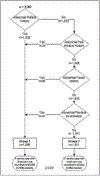Pediatric Chest Pain-Low-Probability Referral: A Multi-Institutional Analysis From Standardized Clinical Assessment and Management Plans (SCAMPs®), the Pediatric Health Information Systems Database, and the National Ambulatory Medical Care Survey
- PMID: 28081617
- PMCID: PMC6388765
- DOI: 10.1177/0009922816684605
Pediatric Chest Pain-Low-Probability Referral: A Multi-Institutional Analysis From Standardized Clinical Assessment and Management Plans (SCAMPs®), the Pediatric Health Information Systems Database, and the National Ambulatory Medical Care Survey
Abstract
We conducted a study to assess test characteristics of red-flag criteria for identifying cardiac disease causing chest pain and technical charges of low-probability referrals. Accuracy of red-flag criteria was ascertained through study of chest pain Standardized Clinical Assessment and Management Plans (SCAMPs®) data. Patients were divided into 2 groups: Group1 (concerning clinical elements) and Group2 (without). We compared incidence of cardiac disease causing chest pain between these 2 groups. Technical charges of Group 2 were analyzed using the Pediatric Health Information System database. Potential savings for the US population was estimated using National Ambulatory Medical Care Survey data. Fifty-two percent of subjects formed Group 1. Cardiac disease causing chest pain was identified in 8/1656 (0.48%). No heart disease was identified in patients in Group 2 ( P = .03). Applying red-flags in determining need for referral identified patients with cardiac disease causing chest pain with 100% sensitivity. Median technical charges for Group 2, over a 4-year period, were US2014$775 559. Eliminating cardiac testing of low-probability referrals would save US2014$3 775 182 in technical charges annually. Red-flag criteria were an effective screen for children with chest pain. Eliminating cardiac testing in children without red-flags for referral has significant technical charge savings.
Keywords: chest pain; pediatric cardiology; quality improvement; subspecialty referral.
Conflict of interest statement
Figures
Similar articles
-
Regional implementation of a pediatric cardiology chest pain guideline using SCAMPs methodology.Pediatrics. 2013 Oct;132(4):e1010-7. doi: 10.1542/peds.2013-0086. Epub 2013 Sep 9. Pediatrics. 2013. PMID: 24019419
-
Regional Implementation of a Pediatric Cardiology Syncope Algorithm Using Standardized Clinical Assessment and Management Plans (SCAMPS) Methodology.J Am Heart Assoc. 2016 Feb 19;5(2):e002931. doi: 10.1161/JAHA.115.002931. J Am Heart Assoc. 2016. PMID: 26896480 Free PMC article.
-
Limited utility of exercise stress tests in the evaluation of children with chest pain.Congenit Heart Dis. 2012 Sep-Oct;7(5):455-9. doi: 10.1111/j.1747-0803.2012.00702.x. Epub 2012 Aug 7. Congenit Heart Dis. 2012. PMID: 22883642
-
Pediatric cardiology update: Office-based practice of pediatric cardiology for the primary care provider.Curr Probl Pediatr Adolesc Health Care. 2003 Nov-Dec;33(10):318-47. doi: 10.1016/s1538-5442(03)00137-8. Curr Probl Pediatr Adolesc Health Care. 2003. PMID: 14627960 Review. No abstract available.
-
Chest Pain in Pediatrics.Pediatr Ann. 2015 Dec;44(12):e274-8. doi: 10.3928/00904481-20151110-01. Pediatr Ann. 2015. PMID: 26678235 Review.
Cited by
-
Association Between Variation in Preoperative Care Before Arterial Switch Operation and Outcomes in Patients With Transposition of the Great Arteries.Circulation. 2018 Nov 6;138(19):2119-2129. doi: 10.1161/CIRCULATIONAHA.118.036145. Circulation. 2018. PMID: 30474422 Free PMC article.
-
Empowering pediatric providers more: mastering management of common complaints.Eur J Pediatr. 2023 Nov;182(11):4767-4770. doi: 10.1007/s00431-023-05158-y. Eur J Pediatr. 2023. PMID: 37589776 No abstract available.
-
Variation in practice patterns in device closure of atrial septal defects and patent ductus arteriosus: An analysis of data from the IMproving Pediatric and Adult Congenital Treatment (IMPACT) registry.Am Heart J. 2018 Feb;196:119-130. doi: 10.1016/j.ahj.2017.10.018. Epub 2017 Nov 2. Am Heart J. 2018. PMID: 29421004 Free PMC article.
-
Chest pain in pediatric patients in the emergency department- Presentation, risk factors and outcomes-A systematic review and meta-analysis.PLoS One. 2024 Apr 16;19(4):e0294461. doi: 10.1371/journal.pone.0294461. eCollection 2024. PLoS One. 2024. PMID: 38626180 Free PMC article.
-
Transcatheter device closure of atrial septal defects: more to think about than just closing the hole.Curr Opin Cardiol. 2018 Jan;33(1):108-116. doi: 10.1097/HCO.0000000000000476. Curr Opin Cardiol. 2018. PMID: 29076870 Free PMC article. Review.
References
-
- Cooley WC, McAllister JW, Sherrieb K, Clark RE. The Medical Home Index: development and validation of a new practice-level measure of implementation of the Medical Home model. Ambulatory pediatrics : the official journal of the Ambulatory Pediatric Association. Jul-Aug 2003;3(4):173–180. - PubMed
-
- The medical home. Pediatrics. July 2002;110(1 Pt 1):184–186. - PubMed
-
- Pantell RH, Goodman BW Jr. Adolescent chest pain: a prospective study. Pediatrics. June 1983;71(6):881–887. - PubMed
-
- Hamburger EK, Lane JL, Agrawal D, Boogaard C, Hanson JL, Weisz J, Ottolini. The referral and consultation entrustable professional activity: defining the components in order to develop a curriculum for pediatric residents. Academic pediatrics. Jan-Feb 2015;15(1):5–8. - PubMed
MeSH terms
Grants and funding
LinkOut - more resources
Full Text Sources
Other Literature Sources
Medical



